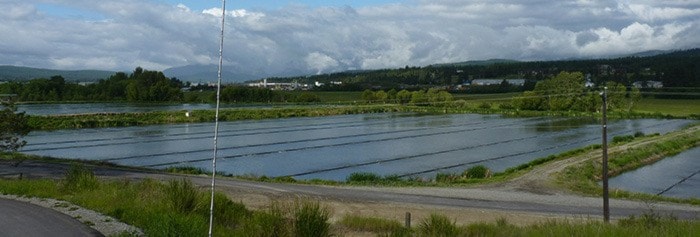When you flush the toilet or drain water from your sink, pipes carry the messy debris from your home to Cranbrook’s wastewater lagoons on the northern edge of town.
Here, Cranbrook Public Works staff prepare the wastewater to be digested by billions of tiny bugs. First, anything that floats – grease and fats, mostly – is siphoned off, then anything solid – flushable wipes, last night’s leftovers you put down the garborator – is lifted out.
What’s left is an appetizing buffet for microorganisms, explains Cranbrook Director of Public Works Joe McGowan, who has me perched on the edge of a sewage lagoon in the name of research.
Once the wastewater has been cleared of floating inorganics and solids that don’t belong, it flows into the first of three wastewater lagoons. This is where those bugs get to work.
“You flush, the lumpy comes down, and 8 billion bugs consume the organic material,” McGowan summarized.
There are two types of bugs that live in the lagoons: aerobic microorganisms, and anaerobic microorganisms.
The first kind, aerobic microorganisms, are the useful ones. Energetic and hardworking, they’re the ones that feed on organic material, and the city creates conditions in the lagoons that will breed and nurture these kinds of bugs. They consume body waste and food waste, while dirt – which comes off you in the shower and your clothes in the washer – sinks to the bottom of the pond.
Anaerobic microorganisms are less helpful – they produce carbon dioxide and sulphates, and they are responsible for making the lagoons smell sometimes.
Fortunately, there’s a surefire way to encourage aerobic bugs, while stopping the anaerobic bugs in their tracks: oxygen. Anaerobic microorganisms don’t like it; while aerobic bugs thrive on it.
“When bugs are working, like you and I they need oxygen,” said McGowan. “As the bug eats the organic material, it consumes oxygen. That is taken out of the water and the water becomes devoid of oxygen, so the bugs die.”
To stop them from dying off, the city pumps oxygen into the lagoons. A series of pipes about 30 feet apart contain nozzles about 20 feet apart that are on the end of diffusers lowered five feet into the water – almost at the bottom of the pond.
These diffusers take a large volume of air and break it into bubbles.
“We shear the air so there are billions of little tiny bubbles every second,” said McGowan.
Because the bugs are small, the bubbles need to be small. And then the aerobic microorganisms really start to party.
“It has the same affect on aerobic bacteria as blood doping did on Lance Armstrong,” said McGowan.
“We take mediocre performing microorganisms and give them the Lance Armstrong treatment. As a result, they perform a lot better.”
The helpful bugs also like sunlight – which is why the ponds are only six feet deep, and why this kind of wastewater system prospers best in sunny climates.
Cranbrook, as we know, is the sunniest city in B.C., and this is another case where that works in our favour. We’re also helped by the natural geography of the city, which for the most part has a gentle slope so everything runs downhill from south to north.
What’s more, when the lagoons were built in 1973, the city used a large piece of property. That means that Cranbrook can simplify its wastewater system by using three ponds and breeding the bugs inside the ponds, rather than circling them back into the wastewater as it arrives, as the City of Kimberley needs to do.
In Cranbrook, there’s no chemical treatment of the wastewater at the lagoons.
“All we are using is hard-working bugs,” said McGowan.
“We’ve gone back to basics – we are using basic scientific concepts. We are able to do it because we have the land area.”
See tomorrow’s Townsman for the conclusion of A Bug’s Life, a feature on Cranbrook’s hardest working employees.
